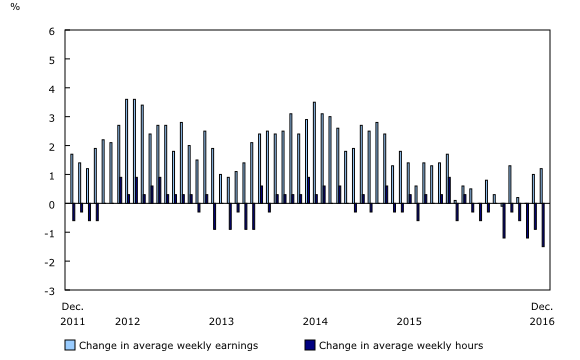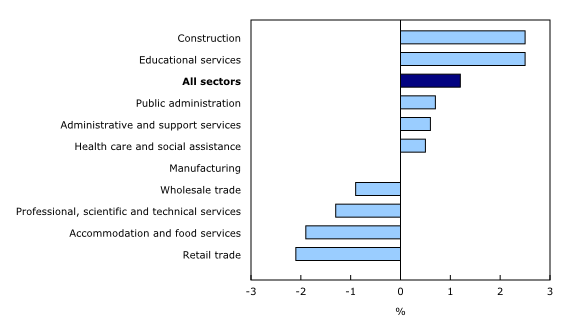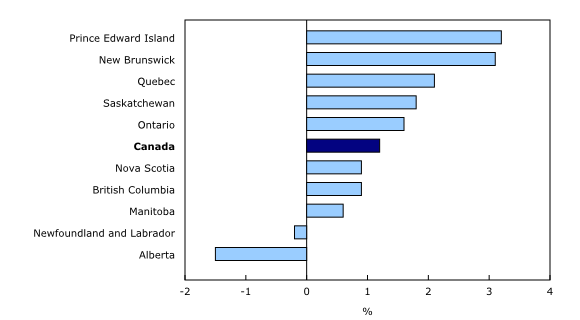Payroll employment, earnings and hours, December 2016
Archived Content
Information identified as archived is provided for reference, research or recordkeeping purposes. It is not subject to the Government of Canada Web Standards and has not been altered or updated since it was archived. Please "contact us" to request a format other than those available.
Released: 2017-02-23
$971.00
December 2016
1.2% 
(12-month change)
$1,035.27
December 2016
-0.2% 
(12-month change)
$834.27
December 2016
3.2% 
(12-month change)
$850.11
December 2016
0.9% 
(12-month change)
$888.50
December 2016
3.1% 
(12-month change)
$894.07
December 2016
2.1% 
(12-month change)
$994.49
December 2016
1.6% 
(12-month change)
$898.69
December 2016
0.6% 
(12-month change)
$1,010.37
December 2016
1.8% 
(12-month change)
$1,129.62
December 2016
-1.5% 
(12-month change)
$933.75
December 2016
0.9% 
(12-month change)
$1,061.46
December 2016
1.3% 
(12-month change)
$1,417.67
December 2016
-1.8% 
(12-month change)
$1,325.59
December 2016
3.9% 
(12-month change)
Average weekly earnings of non-farm payroll employees were $971 in December, an increase of 1.0% from November and 1.2% from 12 months earlier.
In general, changes in weekly earnings reflect a number of factors, including wage growth; changes in the composition of employment by industry, occupation and level of job experience; and average hours worked per week.
Non-farm payroll employees worked an average of 32.8 hours per week in December, little changed from the previous month but down from 33.3 hours in December 2015. Average weekly hours have been on a downward trend since the beginning of 2016.
Average weekly earnings by sector
In the 12 months to December, average weekly earnings increased in 2 of the 10 largest industrial sectors: construction and educational services. At the same time, earnings declined in retail trade, while there was little change in the remaining large sectors.
Compared with 12 months earlier, average weekly earnings in construction were up 2.5% to $1,234. Average weekly earnings were boosted by increases in the heavy and civil engineering construction subsector. Gains in earnings were spread across several provinces, with notable growth in British Columbia and Quebec.
On a year-over-year basis, average weekly earnings in educational services grew 2.5% to $1,042. Increases in earnings were spread across most industries in this sector.
Average weekly earnings in retail trade fell 2.1% to $566 in the 12 months to December. There were several decreases in this sector, primarily in general merchandise stores. Part of the decline was due to retail trade earnings being at a high point in December 2015.
Average weekly earnings by province
In the 12 months to December, average weekly earnings of non-farm payroll employees rose in six provinces. Increases were led by Prince Edward Island, followed by New Brunswick, Quebec, Saskatchewan, Ontario and British Columbia. Earnings declined in Alberta, while there was little change in Nova Scotia, Manitoba and Newfoundland and Labrador.
Average weekly earnings in Prince Edward Island grew 3.2% to $834 compared with December 2015. Increases in earnings were driven by growth in finance and insurance and manufacturing.
In the 12 months to December, average weekly earnings in New Brunswick rose 3.1% to $889. Gains were spread across many sectors, led by finance and insurance. Earnings in the province trended up in the first and fourth quarters of the year, after holding relatively steady in the second and third quarters.
In Quebec, average weekly earnings increased 2.1% to $894 in the 12 months to December. Earnings growth was spread across several sectors, with notable gains in finance and insurance and construction.
Average weekly earnings in Saskatchewan were up 1.8% to $1,010 compared with 12 months earlier. Manufacturing, educational services, health care and social assistance and finance and insurance contributed the most to the increases.
Compared with December 2015, average weekly earnings in Ontario grew 1.6% to $994, with the largest increases in information and cultural industries and finance and insurance. Average weekly earnings in the province have been on an upward trend since September 2016.
In the 12 months to December, average weekly earnings in British Columbia were up 0.9% to $934, driven by increases in finance and insurance, construction and information and cultural industries. Both earnings and employment in the province trended upward in 2016.
Compared with 12 months earlier, average weekly earnings in Alberta were down 1.5% to $1,130. The largest contributors to the decline in December were professional, scientific and technical services as well as wholesale trade. At the same time, earnings were up notably in mining, quarrying and oil and gas extraction, as well as educational services. In addition, earnings in construction were little changed, following year-over-year declines since early 2015. As a result, the downward trend that began in 2015 has lessened in the second half of 2016.
Non-farm payroll employment by sector
The number of non-farm payroll employees increased by 39,200 (+0.2%) in December. The number of payroll jobs grew the most in construction, educational services and professional, scientific and technical services. In December, there were fewer payroll employees working in retail trade and administrative and support services.
On a year-over-year basis, the number of non-farm payroll employees rose by 206,400 (+1.3%). The largest gains were in health care and social assistance (+61,000 or +3.3%), accommodation and food services (+29,900 or +2.4%) and public administration (+25,200 or +2.4%).
Over the same period, there were decreases in payroll jobs in mining, quarrying and oil and gas extraction (-12,200 or -6.1%), wholesale trade (-8,100 or -1.0%) and in the "other services" sector (-5,300 or -1.0%).
Recent labour market developments
In the 12 months to December, the pace of employment growth has been similar in both of Statistics Canada's monthly surveys with data on employment: the Survey of Employment, Payrolls and Hours (SEPH) and the Labour Force Survey (LFS).
From December 2015 to December 2016, both surveys showed employment gains in Quebec, Ontario and British Columbia. More specifically in Quebec, the number of payroll employees in SEPH showed growth of 2.1% while average weekly earnings rose 2.1%, outpacing the national average (+1.2%). Over the same period, according to the LFS, the unemployment rate declined 1.3 percentage points to 6.5%.
Note to readers
With the March 31 release of January 2017 data, the Survey of Employment, Payrolls and Hours (SEPH) will be releasing historically revised estimates. These estimates will include seasonally adjusted data that have been revised based on the latest seasonal factors. Historical revisions will also be made to a number of industries by province and territory.
SEPH is produced by a combination of a census of approximately one million payroll deductions provided by the Canada Revenue Agency, and the Business Payrolls Survey, which collects data from a sample of 15,000 establishments. Federal, provincial and territorial public administration data are collected from various administrative records provided by these levels of government. The key objective of the SEPH is to provide a monthly portrait of the level of earnings and the number of jobs and hours worked by detailed industry at the national, provincial and territorial level.
Estimates of average weekly earnings and hours worked are based on a sample and are therefore subject to sampling variability. This analysis focuses on differences between estimates that are statistically significant at the 68% confidence level. Payroll employment estimates are based on a census of administrative data and are not subject to sampling variability.
Statistics Canada also produces employment estimates from its Labour Force Survey (LFS). The LFS is a monthly household survey, the main objective of which is to divide the working-age population into three mutually exclusive groups: the employed (including the self-employed), the unemployed, and those not in the labour force. This survey is the official source for the unemployment rate, and collects data on the socio-demographic characteristics of all those in the labour market.
As a result of conceptual and methodological differences, estimates of changes from SEPH and LFS do differ from time to time. However, the trends in the data are quite similar. To better understand the conceptual differences between employment measures from the LFS and SEPH, refer to section 8 of the Guide to the Survey of Employment, Payrolls and Hours (72-203-G).
Unless otherwise stated, this release presents seasonally adjusted data, which facilitate comparisons by removing the effects of seasonal variations. For more information on seasonal adjustment, see Seasonally adjusted data – Frequently asked questions.
Non-farm payroll employment data are for all hourly and salaried employees, as well as for the "other employees" category, which includes piece-rate and commission-only employees.
Unless otherwise specified, average weekly hours data are for hourly and salaried employees only and exclude businesses that could not be classified to a North American Industry Classification System (NAICS) code.
All earnings data include overtime pay and exclude businesses that could not be classified to a NAICS code. Earnings data are based on gross taxable payroll before source deductions. Average weekly earnings are derived by dividing total weekly earnings by the number of employees.
With each release, data for the current reference month are subject to revision. Data have been revised for the previous month. Users are encouraged to request and use the most up-to-date data for each month.
Real-time CANSIM tables
Real-time CANSIM tables 281-8023, 281-8026, 281-8047 and 281-8063 will be updated on March 6. For more information, consult the document Real-time CANSIM tables.
Next release
Data on payroll employment, earnings and hours for January will be released on March 31.
Products
A summary table is also available.
Job Vacancy Statistics (5202) from the Survey of Employment, Payrolls and Hours for November are now available in CANSIM.
More information about the concepts and use of the Survey of Employment, Payrolls and Hours and Job Vacancy Statistics is available in the Guide to the Survey of Employment, Payrolls and Hours (72-203-G).
Contact information
For more information, contact us (toll-free 1-800-263-1136; 514-283-8300; STATCAN.infostats-infostats.STATCAN@canada.ca).
To enquire about the concepts, methods or data quality of this release, contact Dylan Saunders (613-762-6972; dylan.saunders@canada.ca) or Client Services (toll-free 1-866-873-8788; statcan.labour-travail.statcan@canada.ca), Labour Statistics Division.
- Date modified:




